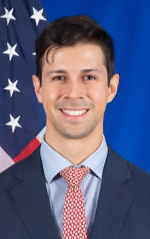At the Crossroads of Tradition and Innovation with AI
Making AI work at State requires challenging the culture that underlies the department’s siloed structure.
BY PAUL KRUCHOSKI
The benefits of artificial intelligence (AI) for diplomacy are not a foregone conclusion. AI promises to revolutionize our work lives, save us time, enable collaboration, and make us more productive—just like email and Teams both did. If you shuddered when I said that, you understand my point: attending to our email and Teams has become a dominant task, and often one that feels totally disconnected from the human relationship–building at the core of our diplomatic craft. It is entirely possible that AI will suffer the same fate, becoming a distraction at best and a time-drain at worst. But it does not have to be that way.
If we address our institutional faults, we can again put people at the center of our work. And I am more convinced than ever that adopting AI is a critical part of how we can successfully navigate the difficult geostrategic moment we are in.
The Strategic Imperative
Adopting AI to support our diplomatic work is not just a matter of efficiency; it’s a strategic imperative. In a world beset with multiple, overlapping crises, our diplomatic corps is stretched thin. AI can help automate administrative tasks, analyze complex data, and provide actionable insights. In doing so, AI can free up diplomats to focus on our core mission: fostering international relationships, negotiating with foreign counterparts, and advancing national interests on the global stage.
First, our diplomatic corps is overworked and stressed, as seen in the State Department’s Federal Employee Viewpoint Survey (FEVS): The percentage of personnel who believe their workload is reasonable has dropped in the last four years, falling from 62 percent in 2020 to 48 percent in 2023. The Global Satisfaction Index at State dropped by seven points over the same period, underperforming other large agencies. We have too few people trying to undertake too many missions around the world. This dissatisfaction not only affects morale; it also undermines the department’s ability to attract and retain talent, further exacerbating the challenges it faces in an increasingly complex and resource-constrained global environment.
Second, our diplomatic operations are simply more complex today. As Secretary Antony Blinken explained in his modernization speech in 2021, we need more expertise in a broader array of areas: climate, global health, cyber security and emerging technologies, economics, and multilateral diplomacy, among others. Building teams (and an organization) that incorporate multiple types of expertise is hard—coordination costs increase, and mastering those skills takes precious time in an organization already stretched thin.
AI won’t solve these problems on its own. But it is a critical ingredient in addressing them. The alternatives aren’t feasible: The cost of our personnel overseas increases every year, and Congress has clearly signaled that we will not grow our way out of the problem. The multiple crises in the world limit our ability to “pivot” away from any part of the world (or any major area of work). Our only choices are to become more efficient in our work (i.e., offload administrative work) and become more effective (i.e., use actionable insights gained from automated data analysis to spend more time on work and relationships that will deliver value). Continuing with the status quo is to become weaker, less resilient, and less competitive as an employer and a diplomatic force.
Data Accessibility and Cultural Change
So how do we avoid missing the moment? Our problem is not technology but the department’s culture. We have much of the underlying technology we need, with more coming online every day. In 2021, the State Department launched “Data.State,” an internal platform that serves as a department-wide repository for shared data and provides department staff access to analytics products and data science tools. Department practitioners are already using generative AI for unclassified work, with a wide range of best practices shared through the AI for Public Diplomacy (AI4PD) campaign. The department is working toward provisioning access to multiple generative AI tools that draw on official, nonpublic information within the next six months. The StateChat tool deployed this spring is an example.
All AI capabilities depend on having accurate, relevant, and (relatively) complete data. This will be our greatest challenge. Information and data stewardship remain largely localized at State. Information is often stored in fragmented systems, captured in ad hoc ways, and hoarded by individuals, hindering accessibility and utility. While the Center for Analytics has done impressive work—making data more accessible, placing chief data officers in bureaus across the department, and ensuring that the right technology is in place—it is not enough.
In part, this is a business process challenge: laying out ground rules at the office, bureau, and agency level for how we structure, store, and share data. But the far larger issue is cultural: We often don’t want to share information, because we are worried about whether others will understand it the same way we do or treat it with the same discretion that we demand. This is a phenomenon I witnessed as the department rolled out its first enterprise contact relationship management system between 2017 and 2020.
This fragmented, stove-piped environment risks us replicating the problems we encountered with other technology adoptions, including both email and Teams: Rather than enhancing productivity, new technology tools have become sources of inefficiency because of a culture that fails to prioritize their effective use. We could end up with thousands of separately trained AI systems, all with incomplete information—and, consequently, drastically limited utility. The result could be a workforce mired in yet more internal coordination and in-house work, far removed from the proactive and strategic engagement that diplomacy requires.
The Path Forward
Addressing these challenges requires technological innovation through data accessibility and a cultural shift toward open information-sharing.
Data Accessibility. Initiatives like Data.State represent a promising start toward making the department’s vast data assets visible, accessible, and interoperable. But we have to go further in unlocking the dramatically siloed data if we ever hope to truly leverage AI to generate insights and support evidence-based decision-making. AI modernization will rely on quality data being shared across the organization. Our current cultural norms and data policies hinder the rapid advances that AI can deliver.
We need to go beyond making existing datasets accessible, though. In 2016, then–Deputy Secretary for Management and Resources Heather Higginbottom worked with MITRE and IDEO to develop a series of recommendations on knowledge management, including an information framework. We need to revive that work, building toward a common data model that covers the core aspects of our diplomatic work: associating our information with the issues, organizations, relationships, contacts, and actions that we are taking.
Open Information-Sharing. Nurturing a culture that values and practices open information-sharing is essential for maximizing the potential of AI. This involves breaking down silos, encouraging collaboration, and ensuring that information is readily available to those who need it, when they need it. We will need ongoing training and a shift in organizational culture to value and reward collaboration and innovation.
But above all, this takes a leadership commitment to shifting the organizing paradigm around information. Information is power. Our goal at the department should be to make every one of our diplomats powerful with the information and nuance necessary. This is a scary leap for many leaders, myself included. People will make mistakes. We have to help our teams learn from those mistakes by providing honest feedback about the impact and consequences of their actions and helping them improve. And I know our diplomatic corps will master working in this new, more open environment, just as we have in the past.
Human Relationships. Ultimately, the success of diplomacy hinges on the quality of human relationships. It’s time to rethink our culture and technology so they enhance our operations, enabling our people to focus on the human element of diplomatic engagement. By embracing data accessibility, fostering a culture of open information-sharing, and reaffirming the primacy of human connections, the State Department can leverage AI not only to enhance its operational efficiency but also to elevate its diplomatic mission.
As we stand at the crossroads of tradition and innovation, the choices made today will shape the future of diplomacy for generations to come. The promise of AI in diplomacy is too great to ignore, and the time to act is now.
When sharing or linking to FSJ articles online, which we welcome and encourage, please be sure to cite the magazine (The Foreign Service Journal) and the month and year of publication. Please check the permissions page for further details.
Read More...
- “Diplomatic Reporting: Adapting to the Information Age” by John G. Gannon, The Foreign Service Journal, July-August 2014
- Technology and Diplomacy: From the FSJ Archive, The Foreign Service Journal, June 2018
- “How AI Could Revolutionize Diplomacy” by Andrew Moore, Foreign Policy, March 2023




